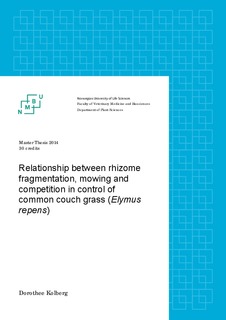| dc.description.abstract | The perennial Elymus repens is considered to be one of the most important weeds on arable land in the Nordic countries. The 1st part of this thesis is principally a literature review on the species` biology and physiology related to control methods and its regrowth capacity, with emphasis on (storage) carbohydrates in plants. Elymus repens’ high tolerance to control measures and its great regeneration ability makes it necessary to combine all possible control methods, direct and preventive, cultural and mechanical. Especially in reduced tillage all available measures might be practiced for optimal control of E. repens: use of competitive crops, mowing and potentially rhizome fragmentation. The 2nd part of the thesis is an independent scientific paper arisen from the experimental part of the master project where the relationship between (i) a simulated innovative belowground (BG) control method of rhizome fragmentation and the common aboveground (AG) control methods, (ii) mowing and (iii) competition (white clover), was investigated in a factorial pot experiment. Elymus repens` response to weed control was recorded in number of early and final shoots, AG and BG biomass and concentrations of simple sugars and fructan. Fragmentation showed a significant effect on some of the responses, but there was no clear linear relationship. Competition from white clover had a significant reducing effect on all responses. Decreasing stubble height had a decreasing effect on BG biomass and fructan concentration in BG plant material. Increasing cutting frequency had a decreasing effect on BG biomass, concentration of simple sugars in AG and of fructan in AG and BG plant material, but stimulated formation of new aerial shoots. The latter might be exploited in a starvation strategy combined with other control treatments. In comparison with reference pots, cutting seemed to be more important than stubble height or the developmental stage at cutting. The study reports several interactions between the different treatment factors and their levels, with essentially synergistic effect or potential to be exploited in a starvation strategy. Among those a new discovery was that high cutting frequency stimulated formation of new aerial shoots. The relative importance of the different factors in this study were competition, stage when cut, stubble height and fragmentation, ranking from high to low importance. In practical use the ranking might be different if different levels of competition are considered. Although the pot experiment may indicate that the innovative method of belowground fragmentation of E. repens has restricted control effect, this method might be more important if its effect is related to an undisturbed system lacking fragmentation totally. | nb_NO |
